In the 1950s, the nuclear mission was king. The US Navy fought hard to get into it, first with heavy planes to carry the early bombs, and then with more conventional attack aircraft armed with lighter weapons. These formed an important part of the nation's nuclear capability both for general war against the Soviet Union, and for specifically naval missions like attacking underground submarine bases.
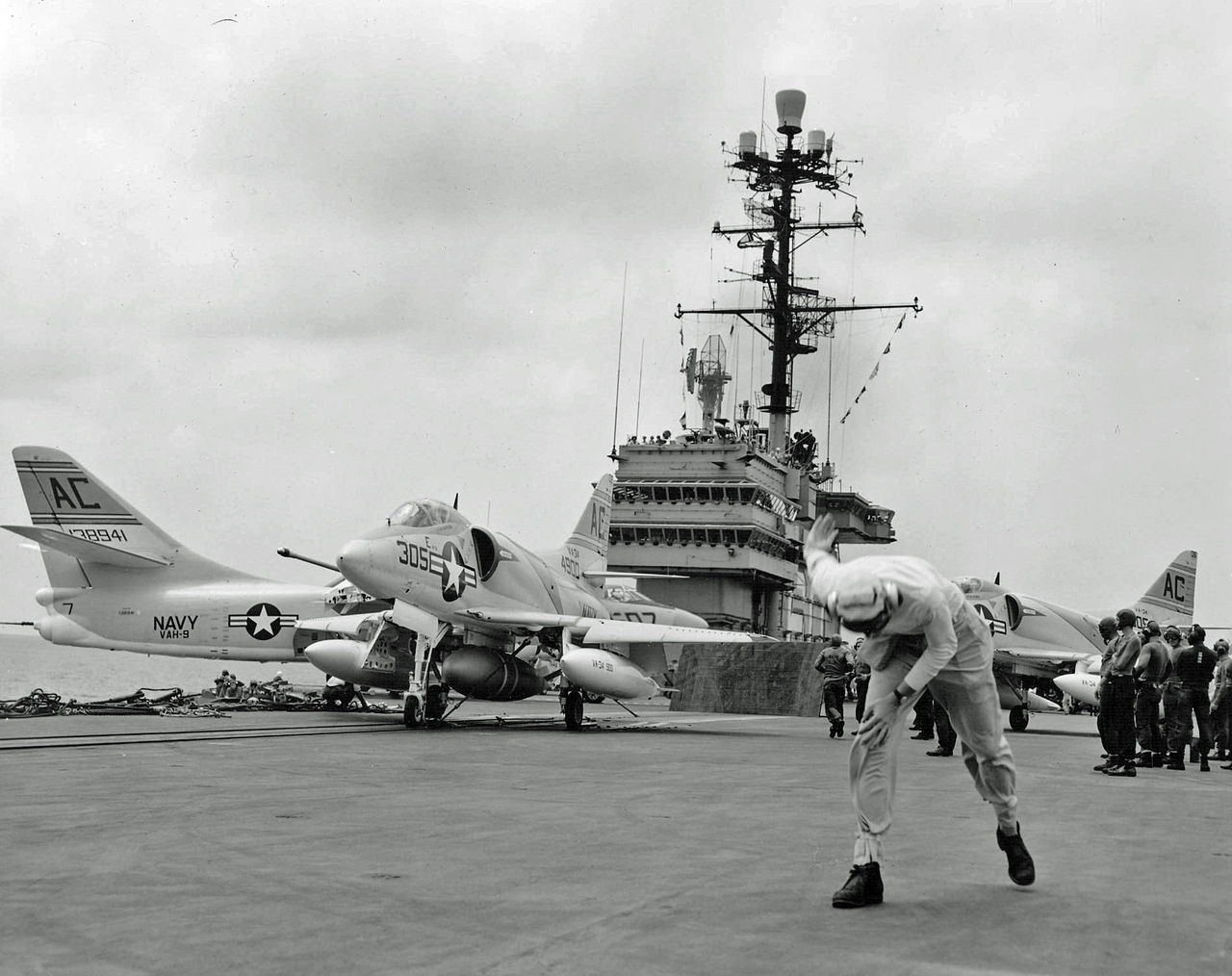
A4D-2 Skyhawk on the catapult with a nuclear bomb
In the late 50s, new aircraft entered service to add capability. The most famous was the A4D (later A-4) Skyhawk, product of legendary Douglas designer Ed Heinemann.1 It was designed around the nuclear delivery mission, and remained in use by the Marines until the 1990s. A few still serve with Argentina and Brazil. More obscure was the FJ-4 Fury, a derivative of the famous F-86 Saber.2 By using buddy refueling, where one aircraft carries extra drop tanks and a hose pod, it could strike targets over a thousand miles away, even further than the much larger A3D was capable of. Eventually, the Skyhawk also gained this capability, and the FJ-4 was retired in the early 60s.
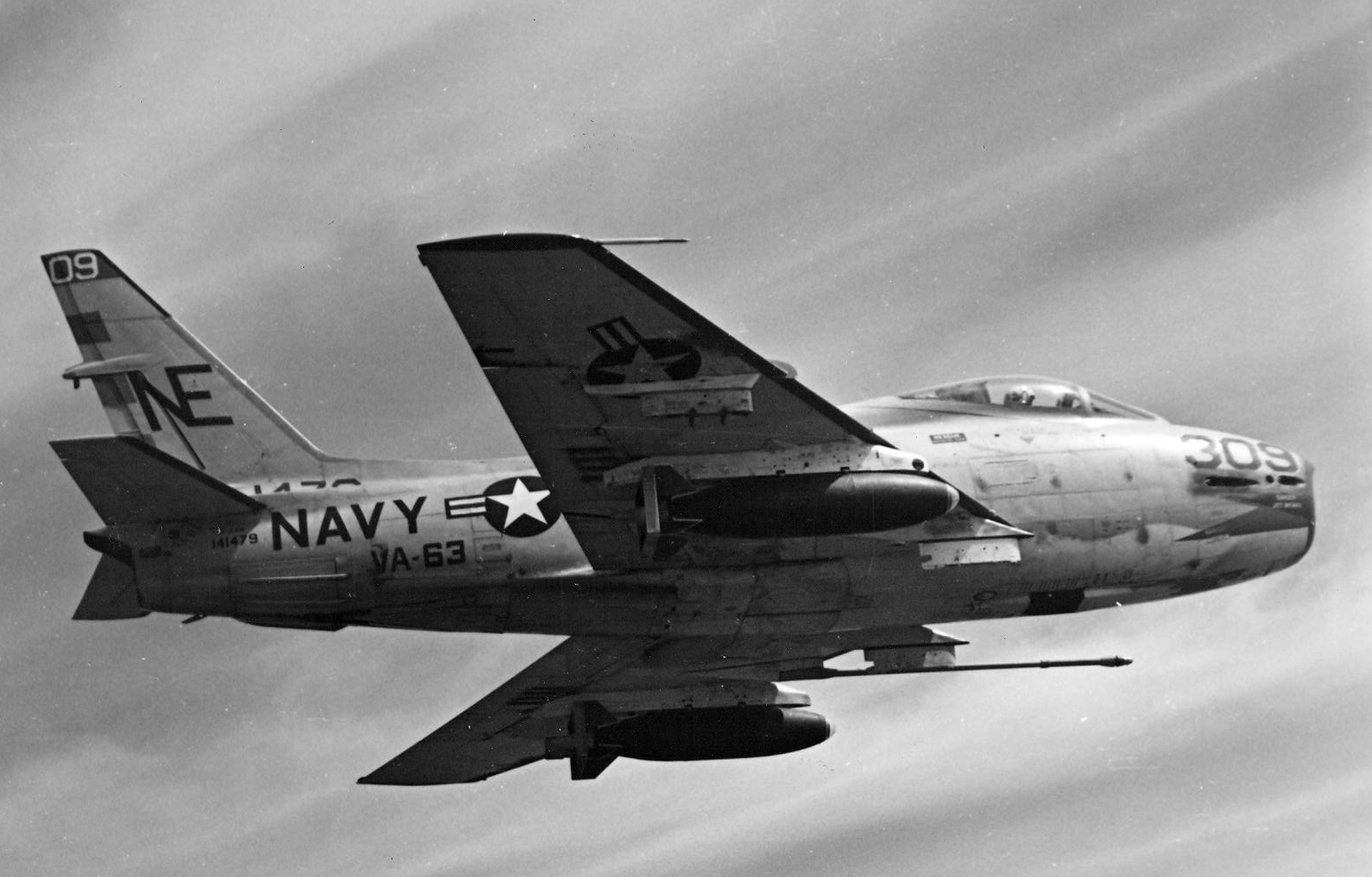
An FJ-4
Throughout the 1950s, the design of implosion weapons continued to improve, as boosting made them lighter and thermonuclear secondaries greatly increased yield. Some work had been done on making them more impact-resistant, largely in conjunction with work on nuclear depth charges, although not enough for a proper penetration bomb of the type used up until then for sub pens.3 The alternative was to use a bigger bomb, detonated on the surface. While it would in theory be possible to impact-fuze the new bombs and toss them at the target, the greater accuracy requirements for attacking hardened targets made this a poor solution. Instead, a new method, known as "laydown", was developed. In this delivery technique, which not only increased accuracy but also greatly improved survivability, the bomb would be released from an aircraft traveling at high speed as low as 200' above the ground. A ribbon parachute would slow it down just enough for the impact-absorbing structures in the bomb to work, keeping it intact while it buried itself in the ground. After the attacking aircraft was safely clear, a time fuze would set it off.
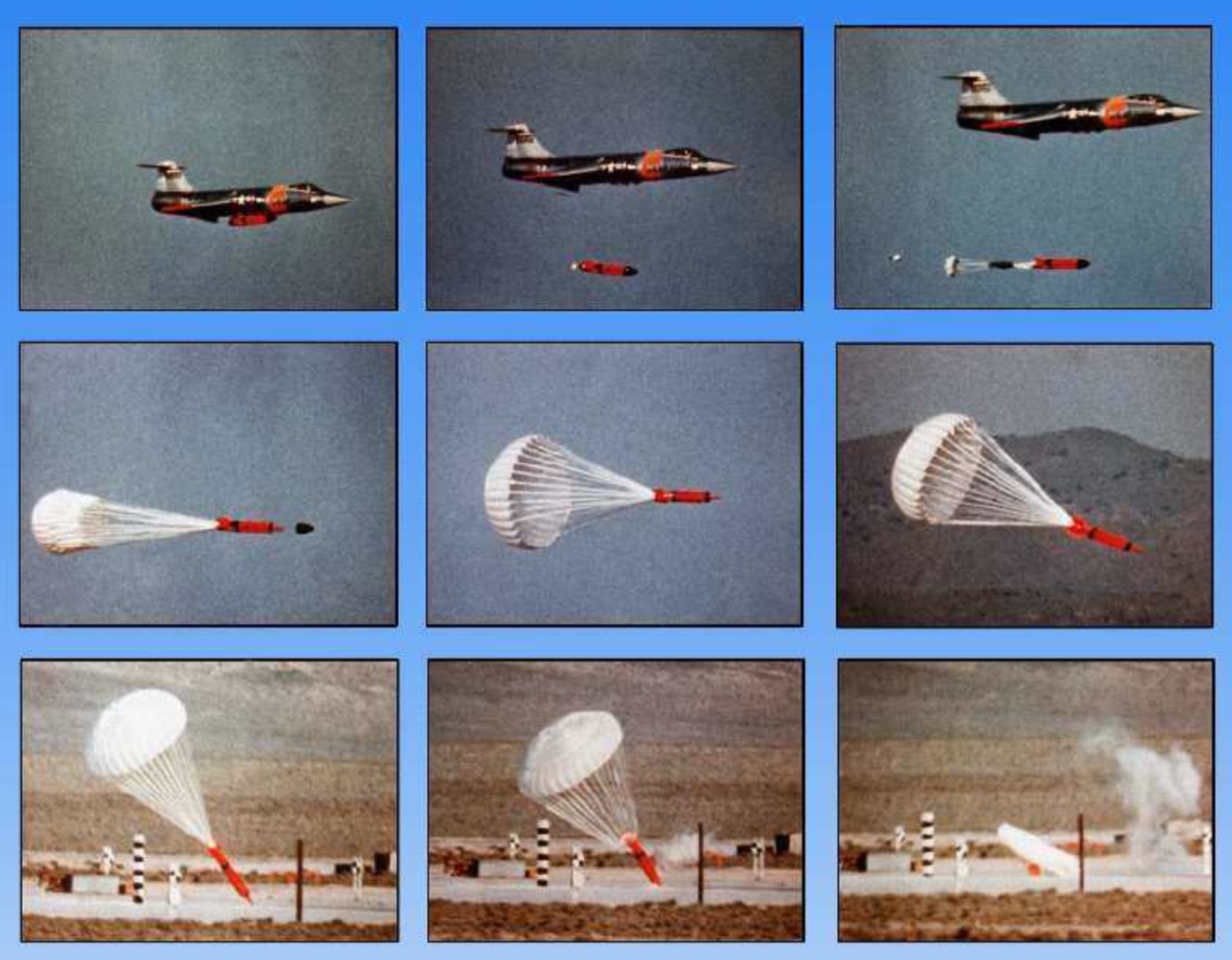
The laydown sequence of a B43 bomb. Note the nose cover being jettisoned, exposing the spike.
The first laydown bomb was the Mk 105 Hotpoint, which used the W34 warhead originally developed for the Lulu depth bomb. It was a relatively small weapon, with a yield of only 11 kT, but it held the line until the arrival of the B43 in the early 60s, a weapon with a yield of up to a megaton and a spike in its nose to keep it from ricocheting. Multiple fuzing options allowed for airburst, ground burst, and laydown, the choice being made depending on the type of target and the delivery method chosen. The B43 and three other weapons made up the bulk of the carrier arsenal throughout the Cold War. These were the B28, the standard US heavy nuclear bomb, the B61, which remains in service today, and the B57, a 500-lb weapon capable of being used as both a bomb and a depth charge.
New aircraft also arrived to carry these weapons, planes which would see out the Cold War. The A-6 Intruder largely took the place of the heavy attack aircraft, relying on advanced avionics and a 2-man crew to enable long-range, low-level missions at night and in all weather. The last variants remained in US service until 2019. The Intruder's lighter stablemate, the A-7 Corsair II, was actually the result of a pivot away from the nuclear mission in the early 60s. Designed to replace the Skyhawk and drop conventional bombs at the lowest cost per target, it was retired in the early 90s, replaced in turn by the F/A-18 Hornet, which took over its nuclear mission.4
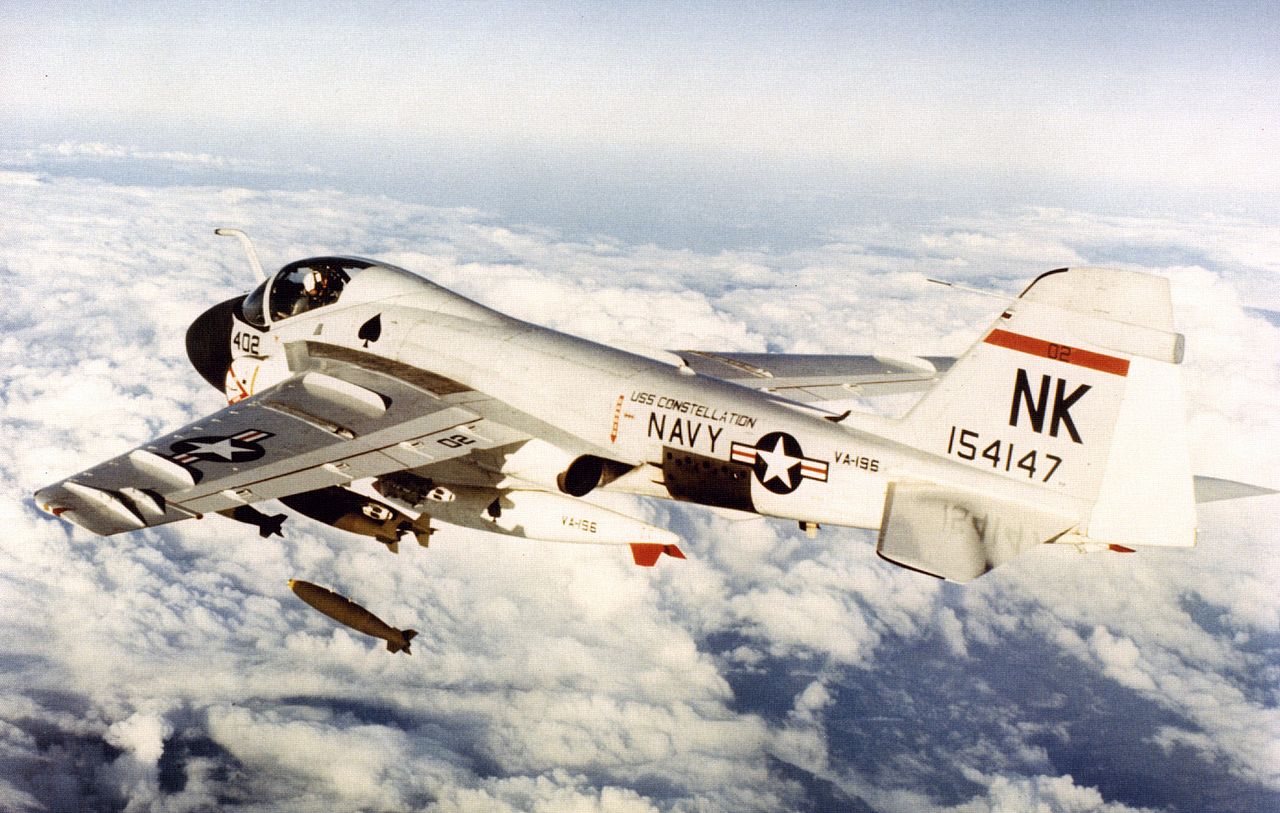
An A-6A Intruder drops bombs over Vietnam
Both of the A-6 and A-7 played important roles in the SIOP, the Single Integrated Operational Plan. This was the combined US nuclear warfighting plan, first set up in 1961, which ensured that the best mix of missiles and airplanes from all services was used to destroy targets as efficiently as possible. Each carrier attack pilot was assigned a specific target before deployment, and had to memorize the preplanned route. In theory, this would keep him clear of any other nuclear weapons, but most pilots were skeptical of their chances of getting back. Because the SIOP timeline was tightly integrated, the aircraft had to be launched from specific points. This tied the carriers to said launch points, limiting their geographical flexibility. In 1976, enough missiles and bombers were available to release the carriers from SIOP. This didn't mean the end of the nuclear mission, though. Instead, they would now form part of the nuclear reserve, hitting whatever targets were missed in the initial wave of attacks.
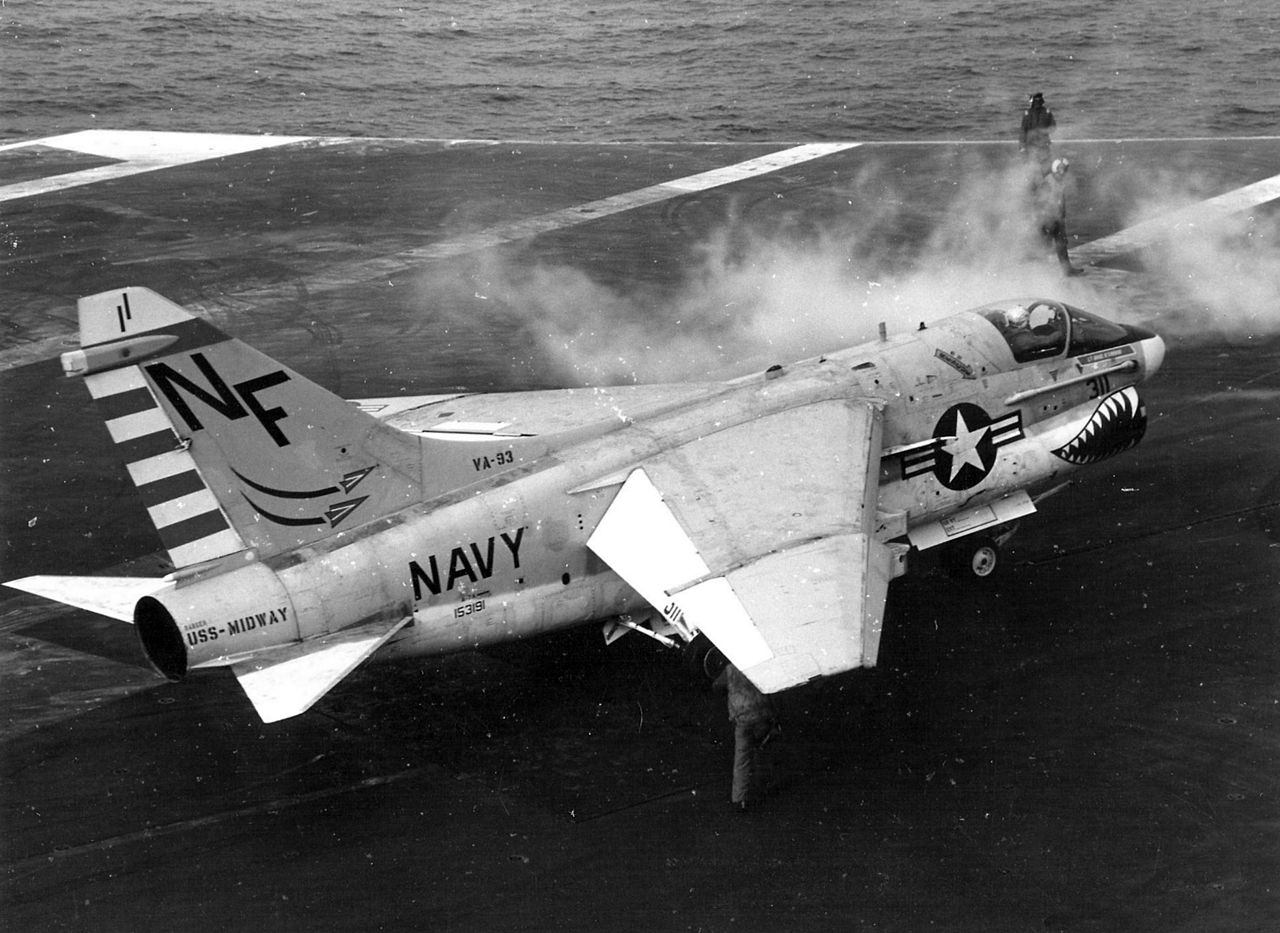
An A-7A Corsair aboard Midway
In September 1991, George Bush announced that the US would withdraw all tactical nuclear weapons deployed afloat, and the Navy's tactical nuclear capabilities have lapsed. The Navy has entirely retired its legacy Hornets, and while the Marines still operate a few squadrons, they no longer deploy aboard carriers and their software and certifications for the nuclear mission became obsolete long ago. The Super Hornet, the Navy's current mainstay, has never even had a nuclear capability, although there was some talk of certification in connection with export sales to Germany5 before the Germans decided to buy F-35s instead. Some residual capability remains on the Nimitz class carriers, which were designed to handle nuclear weapons, although it would take time to restore it. The new Gerald R Ford class carriers are being designed without even that capability. All of this has been made possible by the development of modern guided weapons. In the 1950s and 60s, you could destroy targets with either a single plane and a nuclear weapon or by using massive air raids to hit it with enough conventional bombs. Today, a single plane with a JDAM can do the same job, at a much lower fiscal, environmental and political cost.
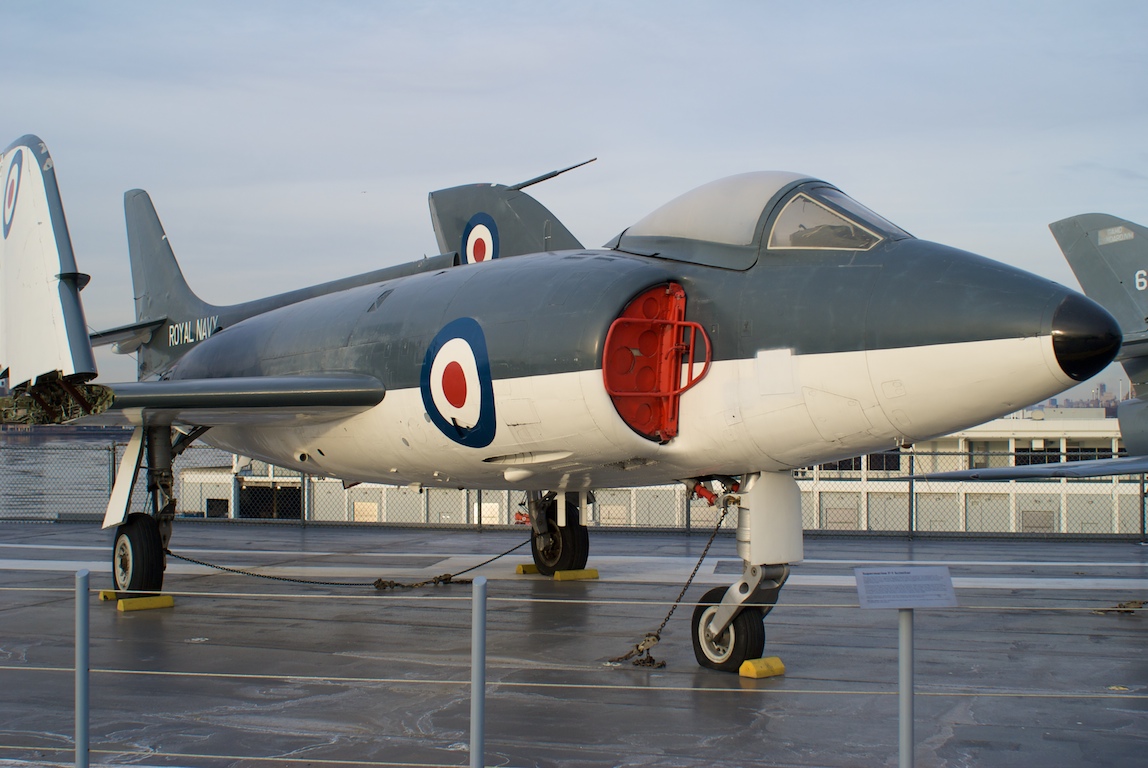
Supermarine Scimitar
But the US wasn't the only power to take nuclear weapons aboard its carriers. The British also fitted their carriers for the nuclear strike mission, although for rather different reasons. In the years immediately after the war, the British were extremely concerned that the new Soviet Sverdlov class cruisers would function as fast commerce raiders, sweeping away the ASW escort forces that they usually used to protect convoys. Any surface hunting group would be too slow to counter them, so they planned to attack them from the air, using a new strike aircraft, which became the Blackburn Buccaneer. To keep the Buccaneer outside the range of the ship's AA guns, it would attack with a nuclear weapon, initially the Red Beard bomb.6 But the Red Beard was ready before the Buccaneer, so it was fitted to the earlier Supermarine Scimitar and De Havilland Sea Vixen as well. And while the main focus of these weapons, five of which were taken to sea aboard each British carrier, was on naval strike, the RN also planned to attack land targets, primarily tactical ones like ports and airfields, as well. Nuclear capability was also important "East of Suez", as it gave the British the ability to bring atomic weapons to bear without the diplomatic and logistical headaches of land basing.
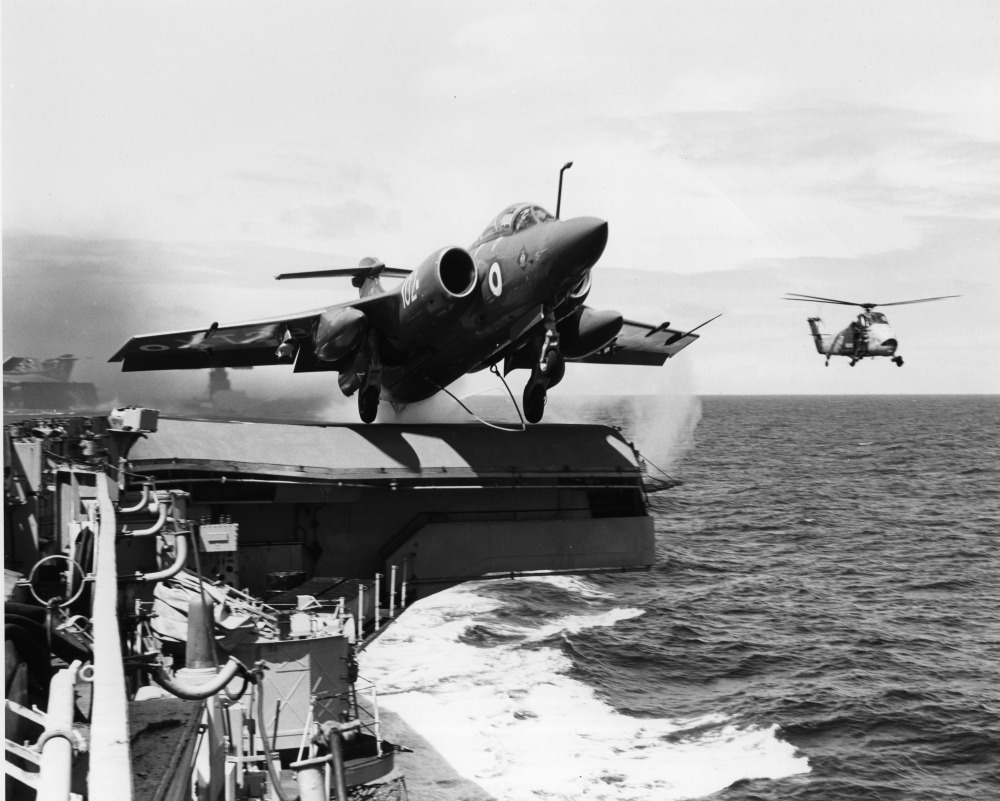
A Buccaneer is catapulted off
In the late 60s, Red Beard was replaced by the lighter WE.177, which could also be used as a |nuclear depth charge. The Buccaneer, which in service proved tremendously successful and turned out to be one of the greatest low-level aircraft ever,7 was eventually retired by the RN when the last conventional carriers were withdrawn in the late 70s, but the nuclear mission was important enough that the Sea Harrier FRS.18 that replaced it retained nuclear capability, for largely the same anti-shipping role that the Buccaneer had originally been intended to fulfill. WE.177 was finally retired by the RN in 1992.
The French have also long had a carrier-based nuclear capability, which they reportedly retain to this day. Unfortunately, I haven't looked into it closely, so can't say much more.

It's not particularly nuclear-related, but this is a KA-6D refueling an A-7E which in turn is refueling an F-4N
But not every nuclear weapon the that navies took to sea was intended to attack land or surface targets. Particularly during the 1950s, panic over the submarine threat led to wide investment in nuclear warheads on various anti-submarine weapons. We'll look at them next time.
1 Heinemann offered the Navy an airplane half the size that everyone else thought would be required for the mission, and delivered the prototype 270 lb underweight. "Heinemann's Hot Rod" was so small that the wings didn't even need to fold, which saved valuable weight. ⇑
2 By this point, the FJ was obsolescent as a fighter, which is why it ended up in the attack squadrons instead. ⇑
3 This doesn't seem to have become possible until the 1980s, with a number of plans being draw up in that era. The end of the Cold War meant that most were cancelled, and the first operational weapon was the B61-11, which entered service in 1997. ⇑
4 This isn't an exhaustive list of nuclear-capable planes flown off of carriers. The F-4 Phantom, for instance, was also equipped to carry nuclear weapons, although as far as I'm aware it was not a major mission for the aircraft. ⇑
5 Germany is committed to supplying a certain number of nuclear delivery platforms to NATO, and is currently facing a shortfall in that role with the retirement of its Tornadoes. ⇑
6 Between 1942 and the late 50s, the British used Rainbow Codes, composed of a color and another word for most of their advanced projects. ⇑
7 There are many credible stories of Buccaneers flying under power lines and the like, apparently enabled by a quirk of aerodynamics that let the plane sit in a very stable ground effect. ⇑
8 Note that the S stood for Strike, which in NATO parlance at the time was explicitly nuclear. ⇑

Comments
During this period, how close to the enemy shore was the navy comfortable sending a carrier group? If they don't feel safe enough to use the Black Sea, doing everything from bases in Turkey (and I guess they had Iran too) makes a lot more sense. Was the Baltic off-limits?
I believe there was discussion of operating in the Black Sea. Definite plans for operations in the eastern Med, and the advantage there is mobility and no need to worry about political currents rendering bases unavailable at a bad time. I'd guess they weren't going into the Baltic. No real need there. Plenty of nearby land bases, and it's a lot more restricted than even the Black Sea. The carriers would stay in the Norwegian sea and attack the Soviet flanks instead.
@bean
"Plenty of nearby land bases"... in the Baltic?
With Sweden & Finland neutral, isn't the only friendly base in the Baltic Bornholm - at the very SW end? Granted, you couldn't ask for a better strategic position if you think the war will be decided in N Germany / Poland.
If it could be made safe, surely the mouth of the Gulf of Finland would be a better place from which to raid Russia-proper. Though, maybe, I am underestimating the ranges of the period's aircraft.
Also, how do the laws of the sea work in the Baltic? Could our hypothetical CBG operate out of the Gulf of Bothia or would that violate neutrality?
"The carriers would stay in the Norwegian sea and attack the Soviet flanks instead."
That means the White Sea bases of Murmansk and Archangel, right? Anything else would seem to require overflying Sweden/Finland with warplanes, which would be a no-no, wouldn't it?
Thank you, and sorry about the foolish questions.
edit: I just remembered one more thing to make our Baltic-CBG's life worse - winter.
Not bases in the Baltic itself, just the fact that there were plenty of land bases in Northern Europe to hit whatever targets need hitting. And there’s the fact that the Baltic is very constrained. It was one of the last places were galleys remained viable, even after they’d become obsolete in the Med. During WWI, the British were unwilling to venture in because of the threat of German torpedo craft. The trend continues today. Finland and Sweden are both basically FAC/corvette only navies, because bigger ships are arguably too risky in there. Carriers are creatures of open water, which the Baltic very much isn’t.
The Gulf of Finland in particular is maybe 30 miles wide. A spotter on each shore is enough to be able to observe visually, and a fast ship can cross in an hour. Your air ops will get messed up by the need to avoid running aground, to say nothing of the threat of mines, torpedo boats and land-based aircraft.
As for the Med, there was a distinct shortage of NATO airbases on that flank until the 60s. Wiki’s 1955 ORBAT for USAFE has nothing outside of Germany, France, the UK and the Netherlands. Which explains why all of the Midways were deployed there. As land-based air was built up in Turkey, Italy and Greece, I believe the Med was de-emphasized and the focus shifted to the Norwegian Sea.
As for Finnish and Swedish neutrality, well, I'm not sure how much NATO would care about that, particularly when neither country was a huge fan of the Soviets, and they'd be unlikely to rock the boat during a global war.
Not a problem, and no need to apologize.
As for the Med, ... Which explains why all of the Midways were deployed there.
If I recall correctly from the tour of the ship, the Midway itself was based in Japan. Which I regarded as a big F.U. to the host nation.
I mean, that would be like if the train from France to England finished in a Station named after a famous English victory over France, like Waterloo. Which it does. But at least the other end of the line is called Calais... which is also a famous English victory over the French. I guess that after enough war everything is a battle at some point.
Midway served for 47 years, so there was plenty of time for both. She spent the first decade or so of her career in the Atlantic, usually deploying with the 6th Fleet in the Med. The rest of her time was in the Pacific, but she wasn't based in Japan until 1973.
Re: Swedish Neutrality. My understanding (based off of not much) is that there was an agreement (probably not written) between the Swedes and NATO that if the Soviets initiated a conventional war in Western Europe, Sweden would fall in and fight alongside NATO (albeit they would mostly be focused on a defensive operation in their own territory). So, that would open up some bases for operations in the Baltic, albeit I don't know how valuable that would be (or even how quickly/if NATO forces would get stationed there). I don't know the periodicity of this posture; my impression was it started in the late 60s or so?
That more or less matches my understanding. I don't know what would have happened during the 50s, but I'd guess that Sweden's ability and willingness to retaliate for a one-time incursion would have been limited. That was a big change that nuclear war brought. Now, a single raid could do massive damage, with a subsequent apology to Sweden, instead of having to repeat the process over and over, which would be a much more flagrant violation of Swedish neutrality.
Hasn't done since 2007, when they finally completed the high speed link between London St. Pancras and the Channel Tunnel.
In fact, Waterloo was only an international station for a relatively brief period- before the Tunnel opened in 1994, the boat trains left from Victoria.
Meanwhile, I don't think a train to Russia or Austria- or in fact to anywhere outside France- has ever left from the Gare d'Austerlitz in Paris. Both this and Waterloo, it turns out, are not named directly after the battles but after nearby bridges which are in turn named after the battles.